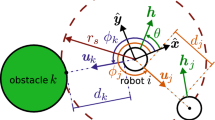Abstract
Flocking, coordinated movement of individuals, widely observed in animal societies, and it is commonly used to guide robot swarms in cluttered environments. In standard flocking models, robot swarms often use local interactions between the robots and obstacles to achieve safe collective motion using virtual forces. However, these models generally involve parameters that must be tuned specifically to the environmental layout to avoid collisions. In this paper, we propose a predictive flocking model that can perform safe collective motion in different environmental layouts without any need for parameter tuning. In the model, each robot constructs a search tree consisting of its predicted future states and utilizes a heuristic search to find the most promising future state to use as the next control input. Flocking performance of the model is compared against the standard flocking model in simulation in different environmental layouts, and it is validated indoors with a swarm of six quadcopters. The results show that more synchronized and robust flocking behavior can be achieved when robots use the predicted states rather than the current states of others.
Access this chapter
Tax calculation will be finalised at checkout
Purchases are for personal use only
Similar content being viewed by others
References
Camazine, S., Deneubourg, J.L., Franks, N.R., Sneyd, J., Theraula, G., Bonabeau, E.: Self-Organization in Biological Systems. Princeton University Press, Princeton (2020)
Couzin, I.D.: Synchronization: the key to effective communication in animal collectives. Trends Cogn. Sci. 22(10), 844–846 (2018)
Dotson, N.M., Yartsev, M.M.: Nonlocal spatiotemporal representation in the hippocampus of freely flying bats. Science 373(6551), 242–247 (2021)
Ferrante, E., Turgut, A.E., Dorigo, M., Huepe, C.: Elasticity-based mechanism for the collective motion of self-propelled particles with springlike interactions: a model system for natural and artificial swarms. Phys. Rev. Lett. 111(26), 268302 (2013)
Fine, B.T., Shell, D.A.: Unifying microscopic flocking motion models for virtual, robotic, and biological flock members. Auton. Robot. 35(2), 195–219 (2013)
Kong, Z., et al.: Perceptual modalities guiding bat flight in a native habitat. Sci. Rep. 6(1), 1–10 (2016)
Liu, Z., Turgut, A.E., Lennox, B., Arvin, F.: Self-organised flocking of robotic swarm in cluttered environments. In: Fox, C., Gao, J., Ghalamzan Esfahani, A., Saaj, M., Hanheide, M., Parsons, S. (eds.) TAROS 2021. LNCS (LNAI), vol. 13054, pp. 126–135. Springer, Cham (2021). https://doi.org/10.1007/978-3-030-89177-0_13
Lyu, Y., Hu, J., Chen, B.M., Zhao, C., Pan, Q.: Multivehicle flocking with collision avoidance via distributed model predictive control. IEEE Trans. Cybern. 51(5), 2651–2662 (2019)
Méhes, E., Vicsek, T.: Collective motion of cells: from experiments to models. Integr. Biol. 6(9), 831–854 (2014)
Okubo, A.: Dynamical aspects of animal grou**: swarms, schools, flocks, and herds. Adv. Biophys. 22, 1–94 (1986)
Parrish, J.K., Viscido, S.V., Grunbaum, D.: Self-organized fish schools: an examination of emergent properties. Biol. Bull. 202(3), 296–305 (2002)
Preiss, J.A., Honig, W., Sukhatme, G.S., Ayanian, N.: Crazyswarm: a large nano-quadcopter swarm. In: 2017 IEEE International Conference on Robotics and Automation (ICRA), pp. 3299–3304. IEEE (2017)
Reynolds, C.W.: Flocks, herds and schools: a distributed behavioral model. In: Proceedings of the 14th Annual Conference on Computer Graphics and Interactive Techniques, pp. 25–34 (1987)
Soria, E., Schiano, F., Floreano, D.: Distributed predictive drone swarms in cluttered environments. IEEE Robot. Autom. Lett. 7(1), 73–80 (2021)
Soria, E., Schiano, F., Floreano, D.: Predictive control of aerial swarms in cluttered environments. Nat. Mach. Intell. 3(6), 545–554 (2021)
Spears, W.M., Spears, D.F., Hamann, J.C., Heil, R.: Distributed, physics-based control of swarms of vehicles. Auton. Robot. 17(2), 137–162 (2004)
Vásárhelyi, G., Virágh, C., Somorjai, G., Nepusz, T., Eiben, A.E., Vicsek, T.: Optimized flocking of autonomous drones in confined environments. Sci. Robot. 3(20), eaat3536 (2018)
Virágh, C., et al.: Flocking algorithm for autonomous flying robots. Bioinspir. Biomim. 9(2), 025012 (2014)
Acknowledgements
This work was partially supported by the EU H2020-FET RoboRoyale (964492).
Author information
Authors and Affiliations
Corresponding author
Editor information
Editors and Affiliations
Rights and permissions
Copyright information
© 2022 Springer Nature Switzerland AG
About this paper
Cite this paper
Önür, G., Turgut, A.E., Şahin, E. (2022). Mind the Gap! Predictive Flocking of Aerial Robot Swarm in Cluttered Environments. In: Dorigo, M., et al. Swarm Intelligence. ANTS 2022. Lecture Notes in Computer Science, vol 13491. Springer, Cham. https://doi.org/10.1007/978-3-031-20176-9_14
Download citation
DOI: https://doi.org/10.1007/978-3-031-20176-9_14
Published:
Publisher Name: Springer, Cham
Print ISBN: 978-3-031-20175-2
Online ISBN: 978-3-031-20176-9
eBook Packages: Computer ScienceComputer Science (R0)




